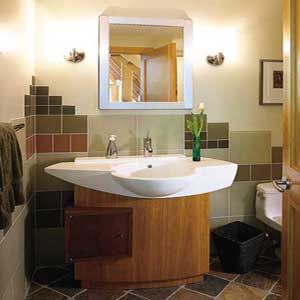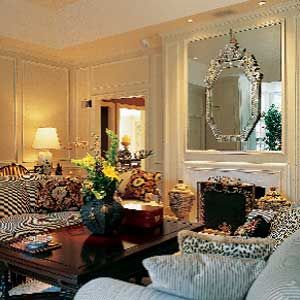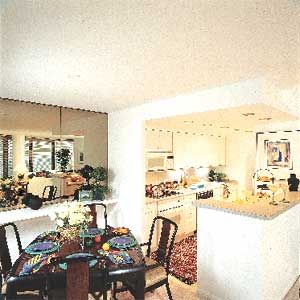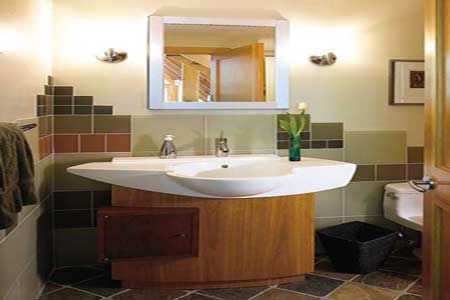
Mirrors are great for knotting ties and putting on makeup. But when installed on a wall or ceiling anywhere in your home—whether in a hall foyer or on the kitchen backsplash—mirrors can make almost any room look bigger. How? They expand the space you see by reflecting the depth and height of a room and sometimes by bringing a pleasant outdoor view inside. They can also brighten a dark room or corner by reflecting light from a window or fixture. And, in a pinch, they even cover surface imperfections or a dated wall treatment.
Home centers sell precut, full-length mirrors that are ready to install on the back of a closet, bedroom or bathroom door. But if you want to mirror a wall or replace the broken mirror above your bath vanity, you’ll need a local shop that specializes in cutting and installing mirror and glass. As a rule of thumb, consider hiring a glazier if you’re dealing with a mirror bigger than about 2×3 ft. Trying to transport, cut and mount anything much larger is risky and not really cost effective given the capabilities and prices of most glaziers. But before calling a glass shop, consider these tips from designers and installers on how to make the most of a mirror’s space-stretching ability and how to tell if you’re getting a quality installation.
OPTIONS AND PRICES
Glaziers stock mirror in sheets as large as 110×144 in., cutting it to size with large specialty saws. Mirror stock is available in three thickness: 1/8 and 3/16 in., both used in frames, and 1/4 in., which can be attached to walls in large sections with mastic and mechanical fasteners. Retail prices for standard, 1/4-in.-thick wall mirror range from $8 to $15 or more per square foot installed. The variation in price depends not on the mirror stock but on the complexity of the installation, how the edges are finished and if the mirror is carved or decorated. “Mirror is mirror,” says Greg Csaki, a vice president of Galaxy Glass, a Fairfield, New Jersey-based installer. “The finishing and installation determine how it looks and what it costs.”
For example, beveled edges can boost the price of a mirror 50 cents per linear inch. Sandblasted or carved designs and gold or silver inlays also add to the cost. Mirrors installed as single, large pieces with hidden mountings cost more than several pieces held in place with molding. And seams concealed by beveled glass strips cost more than plain-butted seams.
You’ll also pay more for cutouts around outlets, switches, plumbing and molding. And because mirror is difficult to ship, the farther you are from the manufacturer, the more you’ll pay (most are located in the southeastern United States).

WHERE THEY LOOK BEST
How large a mirror you choose and where you put it depend on the size of the room and what you want the mirror to do. So start by defining your goal: expand space, multiply light, add drama – or all three. For example, to create the illusion of more space, use a few large panels. Interior designer Camille Waldron, of Camille Waldron Interiors in Franklin Lakes, New Jersey, suggests eliminating seams, which lessen the space-stretching effect.
If you must use more than one piece of mirror, use an odd number of panels. And, suggests Csaki, avoid dividing the wall evenly, or furnishings and light fixtures centered in the room will align with seams and call attention to them. For example, use three 4-ft.-wide mirror panels or one 6-ft.-wide panel flanked by two 3-ft.-wide panels on a 12-ft.-wide wall. Remember, the mirror must fit through all the doors that lead to the installation site.
If adding drama is your top priority, try several narrow strips applied to walls or ceiling. To multiply the effect of light, be sure the light source is reflected in the mirror. Also consider installing lattice over the mirror—the mirror will reflect light and the lattice will diffuse it. And don’t use smoked mirrors, which darken spaces.
Also be sure you know what you’re reflecting. For example, if you locate the mirror opposite a large picture window, is the view attractive? And will the mirror reflect glare elsewhere in the room? Find out by propping up a large framed mirror in the space. Waldron suggests you move it around for a day or two to be sure you’re comfortable with the effect. And if you’re adding a bathroom mirror, stay away from floor-to-ceiling installations. Begin the mirror at waist height or higher to avoid reflecting plumbing or the toilet.
One final point: You’ll find that less is more when it comes to mirrors. To avoid visual confusion, don’t mirror more than two walls in the same room.
GETTING IT INSTALLED
Glaziers are listed in the yellow pages under “Glass” and “Mirrors.” Ask how long the company has been in business and, as always, check references for service level and work quality. Also make sure you get proof of insurance. Then narrow your choice by getting satisfactory answers to the following questions:
Who will do the measuring? A professional should be responsible for this crucial phase. Cutting the mirror as little as 1/4 in. too short or narrow will create a visible gap that’s hard to conceal and looks shabby. And cutting it even 1/4 in. too long will necessitate trimming. Because walls rarely are plumb, mirrors must also be shimmed during installation—often with a tarlike bedding compound—or they end up buckled and bowed.
How are the edges finished? Smaller glazier shops often hand-polish mirror edges; larger companies polish with machines. Both methods ensure smooth, chip-free edges. Better mirror shops go a step further by coating the cut edges with sealant to keep moisture from getting through to the reflective back and eventually tarnishing or oxidizing the mirror. Sealed edges are a must when mirror is installed in a home in a humid climate or along a kitchen backsplash or bath vanity.
How will the mirror be hung? Mirrors must be bonded to the wall with special mastic. Experienced installers know which mastic to use under what circumstances. Several factors determine the types of mastic that are used. Among them is the size of the mirror, whether it is on a wall or ceiling and the type of surface it’s being installed over – painted or unpainted drywall, wood, tile or plaster.
For safety’s sake, manufacturers recommend that all unframed mirrors be installed with at least one type of mastic and a mechanical fastener, such as a decorative molding, J-channel, unobtrusive plastic or metal clips or screws. If plastic fasteners bother you, plan to install decorative light fixtures on the mirror. “The fixture fasteners will hold the mirror up should the glue ever fail,” says Vinnie DeMauro, owner of Countryside Glass & Mirror in Waldwick, New Jersey. Or, have the mirror trimmed with wood molding that will hold it in place.
Once the mirror is installed, look at the opposite ceiling line reflected in the mirror; you should see one continuous plane. “If the mirror looks wavy or there’s a low spot, bulge or a broken plane, it wasn’t installed correctly,” DeMauro explains.
With a quality installation and proper care, a mirror will stretch a space and brighten your home—and expand your visual horizons for years to come.

Bigger Mirrors Demand a Glazier’s Skill
1. Glaziers transport large, fragile, custom-cut mirrors upright in racks on specially outfitted trucks. Once on site, they bring the mirrors indoors so they can reach room temperature before installation; this helps moisture evaporate and reduces the chance of cracking during installation.
2. Rubber gloves help maintain a firm grip on the glass, protect hands and keep body oils and perspiration from corroding the protective backing of the mirrors. Large suction-cup “handles” that create a vacuum grip allow glaziers to handle mirrors easily.
3. All sizable mirrors must be mounted with some type of mastic; these adhesives differ according to the mounting surface and drying time. Larger
installations typically require two mastics – one that dries quickly to secure the mirrors immediately and a second that dries more slowly to keep them in place over time. Mirror manufacturers recommend mechanical fasteners in addition to mastic.
Black bedding compound allows installers to even out the wall and hang the mirrors level and plumb.
4. The quality of the job relies on the skill of the glaziers and their accuracy in duplicating the careful job-site measurements they have taken on the glass when creating cutouts for light switches, outlets and moldings. These cuts are made on large water-cooled saws. The edges are then polished on other specialized equipment.
The Right Way to Clean a Mirror
Moisture is the No. 1 enemy of mirrors. If a wet cleaner is sprayed into the joints, it can puddle, invade the protective coating and eventually deteriorate the reflective silver beneath. That’s what causes those ugly black spots on old mirrors. Instead:
Use a lint-free paper towel or a clean, soft cotton cloth. Old diapers and
T-shirts are great.
Spray a nonabrasive, low-ammonia cleaner on the cloth, not the mirror, so it doesn’t seep into seams. Or, moisten the cloth in 1 gal. of water mixed with
1 cup of rubbing alcohol or 3/4 cup of distilled white vinegar.
Finish by thoroughly drying the mirror, especially around joints and edges, with a soft, grit-free cloth.
Where To Find It:
Countryside Glass & Mirror Inc.
26 Franklin Tpke.
Waldwick, NJ 07463-1737
201/652-8552
Galaxy Glass
Hollywood Park
277 Fairfield Rd.
Fairfield, NJ 07004
973/575-3440
National Glass Association
8200 Greensboro Dr.
McLean, VA 22102
703/442-4890
www.glass.org
Camille Waldron Interiors
Camille Waldron, ASID
668 Farmdale Rd.
Franklin Lakes, NJ 07417
201/337-9510
Additional Reading:
Mirror by Design:Using Reflection to Transform a Space
by Pamela Heyne
John Wiley & Sons
New York, NY; 1996; $54.95

